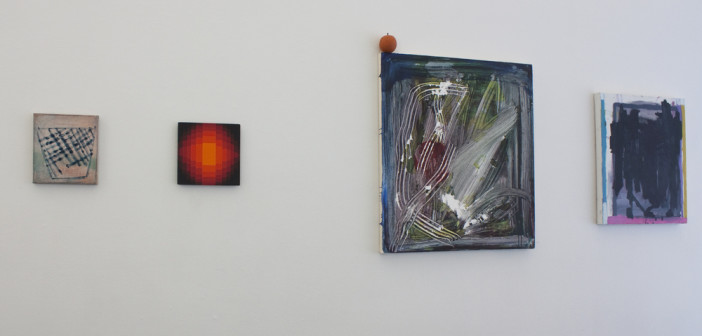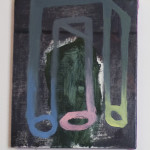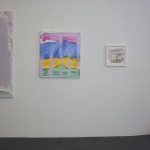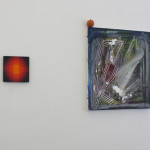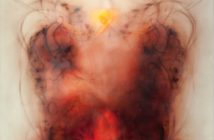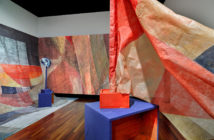The way Smart Paintings is organized might not be in line with the principles of "casualist painting," (an underlying theme of the show), but the friction between the stylized niche these works are said to be fitting into and the almost heavy handed organizational structure utilized by the curator is provocative and unnerving. O'Donnell uses the works of several different artists and opens up a dialogue between the paintings. The show professes to gather together the work of several painters who are asking similar questions about the definitions and properties of painting. However, it seems that O'Donnell's concerns may lie more in using the works of other artists to create one larger piece of art unto itself More than a show about paintings, this is a show that utilizes space to let paintings talk to each other. The result might not be conducive to a typical theme-based curated show but it's certainly challenging.
Is it possible for artists, when they curate shows, to keep their own sensibilities and creative faculties out of the equation? Though I tend to disagree, I believe the personal voice of any curator bleeds through most shows; if that curator is an artist, it seems almost impossible for their own sense of creative play to not seep through and make some sort of artistic statement. This seems especially true in the stylization of Smart Painting. Paintings are hung in a scattered way with no labels, and with uneven spacing between them. It's not enough work to be a salon show, and too much to be something else. This makes it hard to focus on any work in particular, but also equalizes everything in a way and lets the different languages of paint speak to each other, endowing the viewing experience with a sense of whimsy and playfulness. Paragraphs are stenciled on the walls of each room in the gallery, which, at first glance, is redundant but upon further inspection it is refreshing to be given insight as to the inner dialogue of the curator.
Zachary Keating's January is a series of paintings that’s particuarly notable. Keating’s use of bright colors, his melding of mark making and surface disruption spoke nicely to more muted, subdued works like Sharon Butler's Air. Butler's paintings are often on unstretched fabric or canvas, and incorporate elements of drawing and painting; she employs simple mark making techniques such the blue dots in Air floating at the top of sketchy, hexagon forming pencil marks. Tatiana Berg's Tent Paintings, painted on large geometric forms with stretched canvas over them, add a sculptural element to the show. The simplicity of her painterly, vibrant forms are a pleasant counter to more built-up, process based works like Deborah Dancy's Gates of Paradise.
In New York last month, I've been working for the Bruce High Quality Foundation at their Brucennial, which could be seen as a counterpoint to the Whitney's Biennial. The BHQF aims to promote and work with artists outside the confines of the art market and breaks down barriers by placing "knowns" with "unkowns." In the show, work by artists like Jenny Holzer, Ida Applebroog, Tracy Emin, and Joan Mitchell are hung side by side with those yet to be discovered by a broader audience. The organization is a collective of artists whose influence in New York City boasts a show at the Brooklyn Museum, a free University, two gallery spaces, and various other shows and events throughout the city. The Brucennial is a show of all women and its walls are packed to the brim with cutting-edge work in all mediums.
Working for the BHQF raises another issue in my mind: by displaying the works of several artists in one context, and through one lens--here we take the feminist, anti-establishment lens--is power being taken or given to the works at hand? This show is hung salon-style so the viewer needs to wander through several times to view everything. No doubt it's wonderful to see shows like this, and there is certainly a magical feeling in the air: a sort of DIY, underground vibe pervades the space. But again, this is a show where the artists’ sensibilities speak louder than the work itself. If Smart Painting is making an installation piece made out of paintings, Bruce is making a mockery of the exclusivity of the New York Art scene (perfectly seen in the chosen few who exhibit at the Whitney Biennial each year) by jamming in as many avant-garde works as possible. That action speaks louder than a simply formatted theme-based show. This challenge of the notion of exclusivity is further echoed by the fact that the show is all women, a gender which has historically been universally uninvited to the insider's club in most fields.
Maybe instead of asking whether it is okay for artists to use curating as an art form, it would be more imperative to ask why an artist wouldn't choose to experiment within this medium. Art is brought to life by community, and you can't curate without being a part of one. In playing with and arranging the work of those known to them, artists can gain deeper insight into over-arching themes existing in their work as well as the work of those around them. It may not matter whether the show really does what it supposed to be doing. The bigger piece is that others come to bare witness to the sense that someone has made of a collection of objects together, and that feeling of presence we can offer each other is the real gift found in being connected to other artists.

